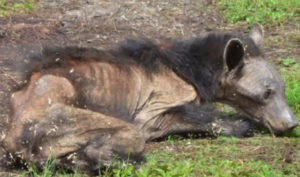
As if local people needed another reason to avoid the illegal practice of feeding wild bears — a few photos surfaced earlier last week on various social media platforms as an important visual reminder.
Mange has been found in a number of black bears throughout the north central region of the state.
“We have seen an increase in mange in our region. It has sort of spread southward,” said Pennsylvania Game Commission Law Enforcement Supervisor Rick Macklem. “A couple of years ago, it was in the McKean and Potter County areas. Now it is in Clinton and Union counties.”
Mange is a skin condition caused by a small insect called a mite.
“The mite burrows into the skin. When you have many mites in one bear, it becomes very uncomfortable. The bear starts scratching itself on whatever it can find, and soon begins losing its hair,” said Pennsylvania Game Commission spokesman Travis Lau. “It can get bad enough to make the bear go off food, become emaciated and even die.”
The mites that cause mange are usually spread by direct contact between bears — which is why the game commission is strongly urging people to avoid feeding bears or doing other things that would cause them to congregate together.
“There is a law prohibiting the intentional feeding of bears. Even an unintentional feeding — where a bear destroys a backyard bird feeder — becomes intentional once someone realizes it attracted a bear,” Lau said. “If one person attracts six bears to feed, and one has mange, then the other five bears will likely contract it as well.”
About a week ago, the game commission received reports of “chupacabres,” as people saw a hairless, emaciated bear but didn’t know what it was at the time.
“Sometimes we get a report from a campground or other outdoors-related place and are able to trap, treat and ultimately release a bear that had mange after it doesn’t pose a threat of infecting other bears,” Macklem said. “If we find a bear that is especially suffering from mange, it may need to be euthanized.”
Lau reported that while humans can contract mange, proper bathing early in the process is key.
“People don’t suffer the effects as much as bears, especially if they wash thoroughly if there is concern they came in contact with any of the mites,” he said. “If there had been longer exposure without proper bathing, a person could get an itchy rash and be uncomfortable — but there would be no permanent long-term effects.”
According to Lau, the increase in cases has less to do with an increase in mange itself, but more the activity of local bears.
“We are currently in the bear breeding season, and it is also the time when young males move around trying to find their own ranges,” he said. “It is a peak time for bear activity, which means it is a peak time for mange to potentially be transferred and noticed by those outdoors.”
The game commission encourages anyone who sees a bear that may have mange to contact the office at 717-787-4250.


